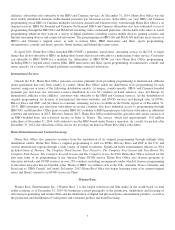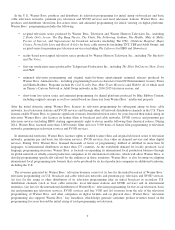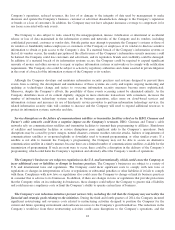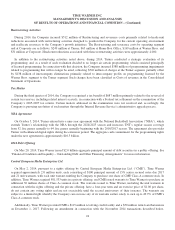Time Magazine 2014 Annual Report Download - page 30
Download and view the complete annual report
Please find page 30 of the 2014 Time Magazine annual report below. You can navigate through the pages in the report by either clicking on the pages listed below, or by using the keyword search tool below to find specific information within the annual report.try to control their programming costs, it may be more difficult for the Company to renew its affiliate agreements on terms,
including those related to pricing, packaging and positioning, that are acceptable to the Company. In addition, due to
consolidation among affiliates in the U.S. and consolidation and growth of large multi-territory distribution companies
internationally, these companies are gaining scale and negotiating power. If the Company is not able to renew its affiliate
agreements on acceptable terms, its subscription revenues may not increase as much as the Company expects or could
decline. In addition, the inability to renew one or more of the Company’s larger affiliate arrangements would reduce the
Company’s subscription revenues and the reach of the Company’s programming, which could make Turner’s cable networks
less attractive to advertisers and result in a decline in advertising revenues.
A decline in the number of multichannel video service subscribers could cause the Company’s subscription revenues to
decline. If multichannel video service rates charged by affiliates continue to increase or economic conditions worsen,
subscribers may (i) cancel their multichannel video service subscriptions, (ii) cancel their subscriptions to HBO and Cinemax or
(iii) elect to subscribe to lower-priced programming packages that may not include HBO, Cinemax or all of Turner’s cable
networks. In addition, consumers, particularly younger consumers, may choose to subscribe to SVOD services as an alternative
to multichannel video services provided by affiliates. The number of HBO and Cinemax subscribers could also decline if
affiliates choose not to market, or reduce their marketing of, HBO and Cinemax. A decline in the number of subscribers to
multichannel video services or HBO or Cinemax could result in a decrease in the Company’s subscription revenues.
A decrease in demand for the television programming produced by Warner Bros. could adversely affect the Company’s
revenues. Warner Bros. is a leading producer of high-quality television programming, as well as a leader in the international
distribution of U.S.-produced television programming. Despite its strong competitive position, Warner Bros.’ television
production business, is largely dependent on the strength of the U.S. broadcast networks, basic cable networks and local
television stations, and their demand for Warner Bros.’ television programming. If there is a decrease in such demand, it
could decrease the overall scale of Warner Bros.’ television production business, reduce the aggregate license fees for its
television programming in the short-term and reduce the aggregate syndication revenues for its television programming in
the long-term. The following factors could increase the likelihood of a decrease in such demand in the U.S.: (i) consolidation
among television station groups and vertical integration between station groups and broadcast networks, thereby reducing the
number of buyers for Warner Bros.’ programming; (ii) vertical integration between television production studios and
broadcast networks, resulting in increased reliance by networks on their in-house and affiliated television production studios;
and (iii) emergence of technological advances and alternative viewing options that could reduce the lifetime value of
television programming. In international territories, the increasing popularity of locally produced television content could
result in decreased demand and lower license fees for the Company’s U.S.-produced television programming.
An increase in the costs incurred by Turner and Home Box Office to acquire or produce popular programming could
adversely affect the Company’s operating results. Competition to acquire popular programming is intense, and the growing
number of SVOD services has increased competition in the U.S. and internationally. Turner may have to increase the price it
is willing to pay for acquired and sports programming, including the renewal of programming it currently licenses. Acquired
and sports programming costs may also increase if Turner seeks the right to distribute the programming on digital platforms
and the right to exhibit programming exclusively during the applicable license period. In addition, the increased amount of
original programming aired by cable networks, premium pay television services and SVOD services could drive up talent
and production costs. If increases in Turner’s and Home Box Office’s costs to produce or acquire popular programming are
not offset by increases in advertising rates and affiliate fees when affiliate agreements are renewed, the Company’s results of
operations could be adversely affected.
The Company’s results of operations could be adversely affected if there is a decline in advertising spending, which
could be caused by a number of factors. A decline in the economic prospects of advertisers or the economy in general could
cause current or prospective advertisers to spend less on television advertising or spend their advertising dollars in other
media. Television advertising expenditures also could be negatively affected by (i) increasing audience fragmentation caused
by increased availability of alternative forms of leisure and entertainment activities; (ii) the increased use of digital video
recorders to skip advertisements; (iii) pressure from public interest groups to reduce or eliminate advertising of certain
products on television; (iv) new laws and regulations that prohibit or restrict certain types of advertisements; and (v) natural
disasters, extreme weather, acts of terrorism, political uncertainty or hostilities, because there may be uninterrupted news
coverage of such events that disrupts regular television programming. In addition, advertisers’ willingness to purchase
advertising time from the Company may be adversely affected by a decline in audience ratings for the programming aired on
14
























